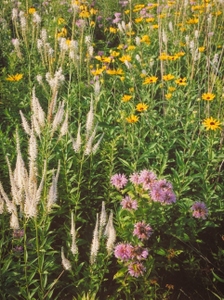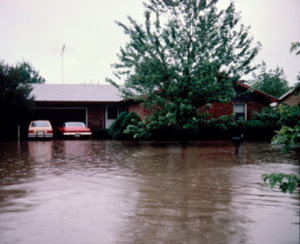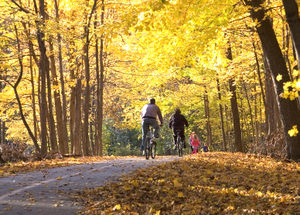With knowledge of the past and an understanding of the present, we can look toward the future and the potential role of ecosystem restoration on a regional scale. The following research describes the relationship between ecosystem restoration and several indicators including biodiversity, stormwater quality and quantity, air quality, community character, quality of life and land value. These indicators can be improved by restoration, and the effects of ecosystem restoration efforts on these indicators can be tracked.
Ecosystem Restoration Indicators
Sep 10, 2013
Ecosystem Indicators
Biodiversity
 As described in the Biodiversity Recovery Plan, biodiversity "can be measured by the number and variety of natural communities that exist side by side in a given area" (Chicago Region Biodiversity Council, 1999). One purpose of restoration is to create a variety of natural communities, making biodiversity a good indicator of an ecosystem's health. For example, this relationship can be utilized in the recovery of forest ecosystems and bird biodiversity in Illinois. Forests have greatly decreased since the 1800's, when they covered 40.8% of the state; as of 1996, forest covered only 14% (IDNR). The remaining forest tracts across Illinois are noted as "small, fragmented, and degraded," which has caused a loss in bird diversity (Ibid). IDNR found that patterns of bird diversity are best supported by larger tracts of forest area and recommended that forest managers tackle the issue of expanding forest coverage areas wherever possible (Ibid). Ecosystem restoration can be a tool to maintain and increase the region's biodiversity and genetic collection that will aid us as factors like climate and population growth patterns continue to change.
As described in the Biodiversity Recovery Plan, biodiversity "can be measured by the number and variety of natural communities that exist side by side in a given area" (Chicago Region Biodiversity Council, 1999). One purpose of restoration is to create a variety of natural communities, making biodiversity a good indicator of an ecosystem's health. For example, this relationship can be utilized in the recovery of forest ecosystems and bird biodiversity in Illinois. Forests have greatly decreased since the 1800's, when they covered 40.8% of the state; as of 1996, forest covered only 14% (IDNR). The remaining forest tracts across Illinois are noted as "small, fragmented, and degraded," which has caused a loss in bird diversity (Ibid). IDNR found that patterns of bird diversity are best supported by larger tracts of forest area and recommended that forest managers tackle the issue of expanding forest coverage areas wherever possible (Ibid). Ecosystem restoration can be a tool to maintain and increase the region's biodiversity and genetic collection that will aid us as factors like climate and population growth patterns continue to change.
Stormwater quality and quantity
Ecosystem restoration increases the quality while decreasing the quantity of stormwater runoff. Native plants' deep root systems are better equipped to filter and absorb stormwater than non-native species. This results in less, better quality stormwater entering our stormwater management infrastructure and natural water bodies as well as decreasing flooding potential (Chicago Region Biodiversity Council, 1999). In September, 2008, rainfall from Hurricane Ike caused flooding throughout the Midwest. Wheaton, IL received 10.51 inches of rain in a two day period and O'Hare International Airport received a record-breaking 6.64 inches in one day (Midwestern Regional Climate Center). Flooding is, unfortunately, a frequent occurrence in various parts of the region. In Lake County, on the Des Plaines River, it is estimated that flooding costs local governments and property owners an average of $20 million annually (Chicago Region Biodiversity Council, 1999). Ecosystem restoration that enhances wetland and other natural community coverage can be useful in decreasing flooding severity.
 |
 |
| A home in Indian Creek, Lake County | After a flood. |
The quality of stormwater is also critical to health of ecosystems and their inhabitants. Rivers, streams, lakes and wetlands are all vulnerable to nonpoint source pollution. Nonpoint source (NPS) pollution comes from many different sources. It is created when water from rain and melting snow flows across our roofs, streets and landscapes, picking up pollutants and carrying them to the nearest waterbody resulting in stormwater runoff. Some of the biggest contributors to contaminated stormwater runoff are agricultural and residential chemicals (like fertilizers and pesticides) and eroded soil from construction sites and farm fields (Funder's Network 2004, 12).
It is important to engage in actions like ecosystem restoration that improve stormwater management. Studies have also shown that watersheds become degraded when more than ten percent of the acreage is covered by impervious surfaces such as roads, parking lots, and roof tops (Ibid). In warmer months as impervious surfaces are heated by the sun, the runoff temperature increases as it is funneled through watersheds. For example warmer water contains less dissolved oxygen affecting fish and plant species that are sensitive to oxygen levels, causing a decline in those communities (Ibid). A strategy paper focused on stormwater best management practices is forthcoming.
Air Quality
The reestablishment of native plant species through ecosystem restoration improves air quality. Compared to traditional lawns and turf grass, natural landscaping and native plants require less maintenance, and can even clean air more efficiently (USEPA, Green Acres). According to the Clean Air Counts campaign, "for every 1,000 acres of natural landscaping, 50 tons of VOCs and 5 tons of NOx are avoided per year" (NIPC, 2004). If restoration sites replace turf grass with natural landscaping, the pollution from landscape maintenance will be greatly reduced. Fossil-fueled lawn equipment emits high levels of carbon monoxide, hydrocarbons (VOCs) and nitrogen oxides (NOx) contributing to green house gases. According to the USEPA, "a gasoline powered lawn mower emits 11 times the air pollution of a new car for each hour of operation" (Ibid).
Many air pollutants removed by ecosystem restoration are the same pollutants that can cause harm to ecosystem functions and biodiversity. Atmospheric pollution is a potent threat to ecosystems because it cannot be contained once it is released. Air pollution can travel for long distances before it is deposited back into the earth through particles or precipitation, impacting a variety of ecosystems along the way. The four frequently cited dangerous air pollutants are sulfur, nitrogen, ground-level ozone, and mercury (Lovett and Tear, 2008). These pollutants result from industrial and manufacturing activities; coal-fired power plants; motor vehicle, plane, train emissions; agricultural and construction operations; and small emitters like gas stations and dry-cleaners. Additionally, carbon dioxide is emitted through similar polluting activities and is a major component of greenhouse gases (see Section V: Impact on Climate Change). All of these air pollutants are capable of damaging vegetation, wildlife, and habitat, and some effects on ecosystems are irreversible or immeasurable in the shorter term.
As reported by the Illinois EPA in its Air Quality Annual Report (2006), there has been a decline in air pollution statewide in the last ten years. CMAP's Regional Air Quality Snapshot (forthcoming) looks more specifically at the levels of air pollution in northeastern Illinois, and found similar results. However, the region remains in nonattainment for the Clean Air Act, meaning that air pollution is still at unhealthy levels.
Community Character
Residential patterns and recreational activities around the world show that people have a connection to nature and appreciate the landscapes that ecosystems and biodiversity offer. Many of these benefits exist outside the economic realm. Clean air and water as well as improved overall health conditions are just a few of these public goods. Open space encourages physical activity and has been proven to reduce stress and add aesthetic value to everyday life (Costanza et al. 1997, 387).
 |
|
Photo by CMAP Photography Contest Participant, Kawamura Kazuya |
In the Chicago Wilderness Region, we have convenient access and support for open space close to our communities. In 1994, there were an estimated 40 million visits to Forest Preserves in Cook County and in Lake County 75% of residents surveyed stated that they had visited forest preserves within two years of the survey (Richard Day Research 1998, Chicago Region Biodiversity Council, 1999). Across the region, several referendums have been passed to preserve open-space. Collectively between DuPage, Kane, Will, and Lake Counties, a total of $250 million was approved in the late 1990's (Chicago Region Biodiversity Council, 1999).
As evidence to residents' value of open space, the economic value of land tends to increase with proximity to open space and parks. Residents are willing to pay a premium for the positive attributes associated with living close to nature. The CMAP Open Space and Parks strategy paper covers this topic in more detail.
Sep 10, 2013
Ecosystem Indicators
With knowledge of the past and an understanding of the present, we can look toward the future and the potential role of ecosystem restoration on a regional scale. The following research describes the relationship between ecosystem restoration and several indicators including biodiversity, stormwater quality and quantity, air quality, community character, quality of life and land value. These indicators can be improved by restoration, and the effects of ecosystem restoration efforts on these indicators can be tracked.
Biodiversity
 As described in the Biodiversity Recovery Plan, biodiversity "can be measured by the number and variety of natural communities that exist side by side in a given area" (Chicago Region Biodiversity Council, 1999). One purpose of restoration is to create a variety of natural communities, making biodiversity a good indicator of an ecosystem's health. For example, this relationship can be utilized in the recovery of forest ecosystems and bird biodiversity in Illinois. Forests have greatly decreased since the 1800's, when they covered 40.8% of the state; as of 1996, forest covered only 14% (IDNR). The remaining forest tracts across Illinois are noted as "small, fragmented, and degraded," which has caused a loss in bird diversity (Ibid). IDNR found that patterns of bird diversity are best supported by larger tracts of forest area and recommended that forest managers tackle the issue of expanding forest coverage areas wherever possible (Ibid). Ecosystem restoration can be a tool to maintain and increase the region's biodiversity and genetic collection that will aid us as factors like climate and population growth patterns continue to change.
As described in the Biodiversity Recovery Plan, biodiversity "can be measured by the number and variety of natural communities that exist side by side in a given area" (Chicago Region Biodiversity Council, 1999). One purpose of restoration is to create a variety of natural communities, making biodiversity a good indicator of an ecosystem's health. For example, this relationship can be utilized in the recovery of forest ecosystems and bird biodiversity in Illinois. Forests have greatly decreased since the 1800's, when they covered 40.8% of the state; as of 1996, forest covered only 14% (IDNR). The remaining forest tracts across Illinois are noted as "small, fragmented, and degraded," which has caused a loss in bird diversity (Ibid). IDNR found that patterns of bird diversity are best supported by larger tracts of forest area and recommended that forest managers tackle the issue of expanding forest coverage areas wherever possible (Ibid). Ecosystem restoration can be a tool to maintain and increase the region's biodiversity and genetic collection that will aid us as factors like climate and population growth patterns continue to change.
Stormwater quality and quantity
Ecosystem restoration increases the quality while decreasing the quantity of stormwater runoff. Native plants' deep root systems are better equipped to filter and absorb stormwater than non-native species. This results in less, better quality stormwater entering our stormwater management infrastructure and natural water bodies as well as decreasing flooding potential (Chicago Region Biodiversity Council, 1999). In September, 2008, rainfall from Hurricane Ike caused flooding throughout the Midwest. Wheaton, IL received 10.51 inches of rain in a two day period and O'Hare International Airport received a record-breaking 6.64 inches in one day (Midwestern Regional Climate Center). Flooding is, unfortunately, a frequent occurrence in various parts of the region. In Lake County, on the Des Plaines River, it is estimated that flooding costs local governments and property owners an average of $20 million annually (Chicago Region Biodiversity Council, 1999). Ecosystem restoration that enhances wetland and other natural community coverage can be useful in decreasing flooding severity.
 |
 |
| A home in Indian Creek, Lake County | After a flood. |
The quality of stormwater is also critical to health of ecosystems and their inhabitants. Rivers, streams, lakes and wetlands are all vulnerable to nonpoint source pollution. Nonpoint source (NPS) pollution comes from many different sources. It is created when water from rain and melting snow flows across our roofs, streets and landscapes, picking up pollutants and carrying them to the nearest waterbody resulting in stormwater runoff. Some of the biggest contributors to contaminated stormwater runoff are agricultural and residential chemicals (like fertilizers and pesticides) and eroded soil from construction sites and farm fields (Funder's Network 2004, 12).
It is important to engage in actions like ecosystem restoration that improve stormwater management. Studies have also shown that watersheds become degraded when more than ten percent of the acreage is covered by impervious surfaces such as roads, parking lots, and roof tops (Ibid). In warmer months as impervious surfaces are heated by the sun, the runoff temperature increases as it is funneled through watersheds. For example warmer water contains less dissolved oxygen affecting fish and plant species that are sensitive to oxygen levels, causing a decline in those communities (Ibid). A strategy paper focused on stormwater best management practices is forthcoming.
Air Quality
The reestablishment of native plant species through ecosystem restoration improves air quality. Compared to traditional lawns and turf grass, natural landscaping and native plants require less maintenance, and can even clean air more efficiently (USEPA, Green Acres). According to the Clean Air Counts campaign, "for every 1,000 acres of natural landscaping, 50 tons of VOCs and 5 tons of NOx are avoided per year" (NIPC, 2004). If restoration sites replace turf grass with natural landscaping, the pollution from landscape maintenance will be greatly reduced. Fossil-fueled lawn equipment emits high levels of carbon monoxide, hydrocarbons (VOCs) and nitrogen oxides (NOx) contributing to green house gases. According to the USEPA, "a gasoline powered lawn mower emits 11 times the air pollution of a new car for each hour of operation" (Ibid).
Many air pollutants removed by ecosystem restoration are the same pollutants that can cause harm to ecosystem functions and biodiversity. Atmospheric pollution is a potent threat to ecosystems because it cannot be contained once it is released. Air pollution can travel for long distances before it is deposited back into the earth through particles or precipitation, impacting a variety of ecosystems along the way. The four frequently cited dangerous air pollutants are sulfur, nitrogen, ground-level ozone, and mercury (Lovett and Tear, 2008). These pollutants result from industrial and manufacturing activities; coal-fired power plants; motor vehicle, plane, train emissions; agricultural and construction operations; and small emitters like gas stations and dry-cleaners. Additionally, carbon dioxide is emitted through similar polluting activities and is a major component of greenhouse gases (see Section V: Impact on Climate Change). All of these air pollutants are capable of damaging vegetation, wildlife, and habitat, and some effects on ecosystems are irreversible or immeasurable in the shorter term.
As reported by the Illinois EPA in its Air Quality Annual Report (2006), there has been a decline in air pollution statewide in the last ten years. CMAP's Regional Air Quality Snapshot (forthcoming) looks more specifically at the levels of air pollution in northeastern Illinois, and found similar results. However, the region remains in nonattainment for the Clean Air Act, meaning that air pollution is still at unhealthy levels.
Community Character
Residential patterns and recreational activities around the world show that people have a connection to nature and appreciate the landscapes that ecosystems and biodiversity offer. Many of these benefits exist outside the economic realm. Clean air and water as well as improved overall health conditions are just a few of these public goods. Open space encourages physical activity and has been proven to reduce stress and add aesthetic value to everyday life (Costanza et al. 1997, 387).
 |
|
Photo by CMAP Photography Contest Participant, Kawamura Kazuya |
In the Chicago Wilderness Region, we have convenient access and support for open space close to our communities. In 1994, there were an estimated 40 million visits to Forest Preserves in Cook County and in Lake County 75% of residents surveyed stated that they had visited forest preserves within two years of the survey (Richard Day Research 1998, Chicago Region Biodiversity Council, 1999). Across the region, several referendums have been passed to preserve open-space. Collectively between DuPage, Kane, Will, and Lake Counties, a total of $250 million was approved in the late 1990's (Chicago Region Biodiversity Council, 1999).
As evidence to residents' value of open space, the economic value of land tends to increase with proximity to open space and parks. Residents are willing to pay a premium for the positive attributes associated with living close to nature. The CMAP Open Space and Parks strategy paper covers this topic in more detail.